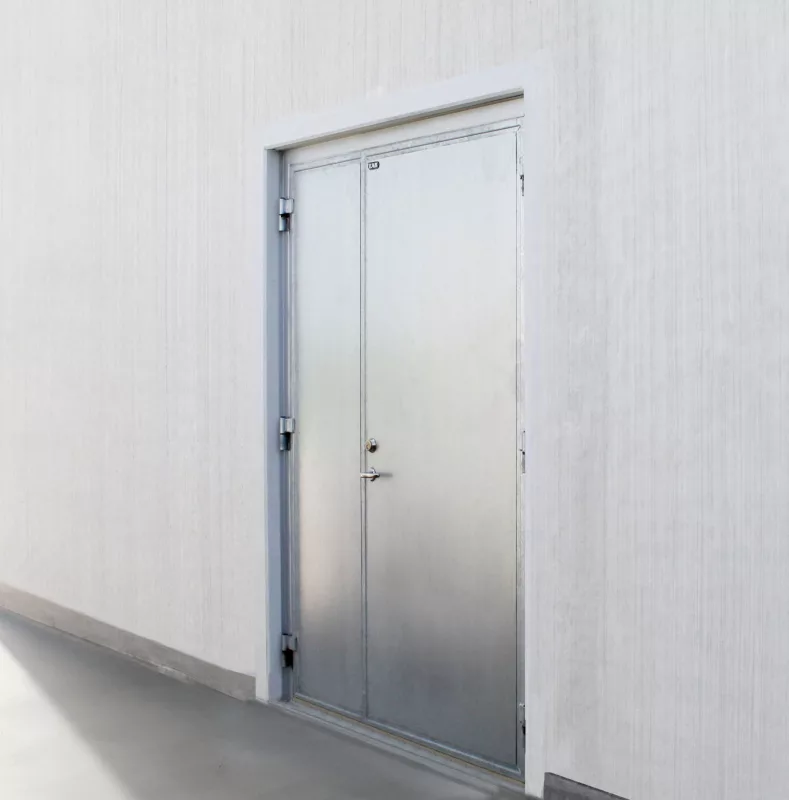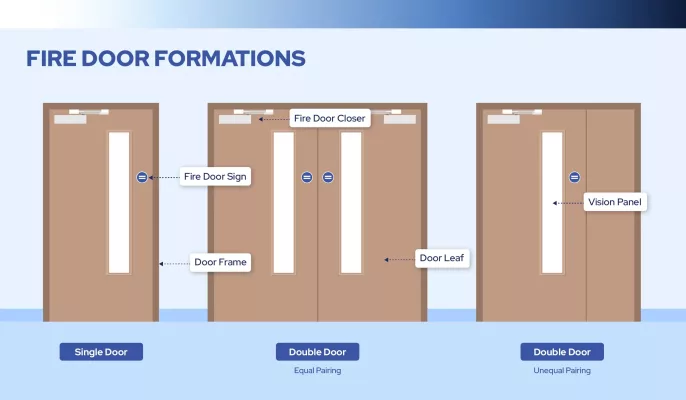When it comes to building safety, Fire Door Steel Thickness is not just a technical detail—it is the backbone of a door’s ability to protect lives and property. Many people focus on the outward appearance or the price tag of a fire door, but the real safeguard lies in the steel sheet hidden inside the structure. From Galvanized Steel Fire Doors in hospitals and schools to heavy-duty models for industrial facilities, the fire door specifications surrounding thickness determine whether a door can hold back flames and smoke long enough to allow safe evacuation.

Understanding fire rated door requirements is essential, because the thickness of the steel directly affects fire resistance, compliance with legal standards, durability, and even long-term cost-effectiveness. In this guide, we will explore why fire door steel thickness matters, how different ratings correspond to material demands, what codes like NFPA 80, UL 10C, EN 1634-1, and GB 12955-2008 require, and why investing in a properly built door delivers both compliance and long-term value.
The Science Behind Fire Doors: How Steel Thickness Withstands Extreme Heat
The primary mission of a fire safety door is straightforward yet vital: it must hold back flames and smoke for a defined period—commonly 30, 60, or 90 minutes—long enough to allow evacuation and rescue operations. To achieve this, the material composition and fire door steel thickness are non-negotiable elements of performance. A useful analogy is comparing a thick blanket to a thin shirt: both may shield you from a candle flame for a moment, but only the thicker layer buys you real time before the heat penetrates.
From a physical perspective, galvanized steel used in fire doors acts as both a thermal barrier and a structural frame. Steel conducts heat efficiently, which means that in a fire scenario, it quickly absorbs and transfers thermal energy. When the sheet is too thin—say below the typical 1.0–1.5 mm specification for galvanized steel fire doors—its temperature can rise to critical failure points within minutes. According to ISO 834 and EN 1634 fire resistance tests, a fire door fails once the average unexposed surface temperature increases by more than 140 °C, or any single point exceeds 180 °C. Once this threshold is reached, deformation begins, hinges distort, and the integrity of the fire door collapses.
By contrast, a compliant galvanized steel fire door with adequate thickness behaves differently. Steel’s specific heat capacity (approximately 0.49 J/g·K at room temperature) means that a thicker sheet absorbs more heat before reaching the same rise in temperature. This translates directly into longer fire endurance. Moreover, the zinc coating—typically 90–275 g/m² according to ASTM A653 or GB/T 2518 standards—provides not only corrosion resistance but also contributes marginally to delaying oxidation under fire exposure. Together, these factors extend the door’s structural stability, slowing down heat transfer and preventing premature breach.
The Critical Role of Thermal Resistance
When flames attack a fire safety door, the steel skin is the first defense. Thermal resistance, or the ability of a material to resist heat flow, increases proportionally with both thickness and mass. In practice, this means a 2 mm galvanized steel sheet will take almost twice as long to reach deformation thresholds compared to a 1 mm sheet, all else being equal. The thicker plate functions like a heat reservoir: it absorbs energy, redistributes it through the surface, and delays the rise of temperature on the protected side of the door. This delay is critical, as every extra minute of containment can prevent smoke spread, maintain oxygen balance, and create survival time for building occupants.
Laboratory tests from UL 10C and Chinese GB 12955 fire door standards consistently demonstrate that doors with undersized steel skins fail early—not because the core insulation is absent, but because the steel envelope loses its shape and integrity. The zinc-coated steel is therefore not just a passive covering; it is the active shield that resists flame penetration, maintains lock alignment, and preserves the pressure differential that prevents smoke migration.
Beyond the Standard: What Happens When Steel is Too Thin?
Imagine a commercial building fire where the so-called “fire door” is manufactured with substandard 0.6 mm sheets instead of the required 1.2 mm galvanized steel. Within minutes, the intense radiant heat drives the thin steel past 500 °C, approaching the softening range where yield strength drops by nearly 50%. The panel begins to warp, gaps appear between the leaf and the frame, and hot gases jet through the cracks. Instead of blocking the blaze, the door transforms into a dangerous vent, accelerating flame spread and feeding oxygen into the compartment. In such a case, what was labeled a fire door becomes a liability, nullifying the purpose of fire compartmentalization.
This failure scenario underscores the importance of fire door compliance. Thickness is not a cosmetic specification; it is the boundary between a reliable fire door specification and a false sense of security. The galvanized steel thickness, its zinc content, and adherence to international standards are the silent guarantees behind every minute of resistance a fire safety door provides.
References: ISO 834 Fire Resistance Tests; EN 1634-1 Fire Door Testing; UL 10C Positive Pressure Fire Tests of Door Assemblies; GB 12955-2008 Fire Doors Standard; ASTM A653/A653M Standard Specification for Steel Sheet, Zinc-Coated (Galvanized).
Structural Integrity: Preventing Door Warping and Collapse During a Fire
Fire is not just a source of heat; it is a violent force that generates explosive pressure, turbulent smoke, and destructive impacts. In a real-world blaze, a fire safety door must withstand not only soaring temperatures but also the force of expanding hot gases pressing against its surface. Add to this the possible impact of falling debris, or the sudden surge of water from a high-pressure fire hose, and it becomes clear why fire door steel thickness is critical for ensuring structural stability.
A compliant galvanized steel fire door achieves this resilience through mass and rigidity. Thicker steel plates exhibit higher flexural strength, which allows the door leaf to resist bending even when exposed to temperatures where steel’s yield strength has dropped by 40–50% (typically above 500 °C). By maintaining its shape, the door continues to sit flush within its frame, preventing dangerous gaps that could allow fire and smoke to penetrate. Without adequate thickness, however, the leaf risks buckling, bowing, or collapsing inward—transforming a protective barrier into an uncontrolled opening.
Equally important are the connection points. Hinges, locks, and panic bars are all anchored directly to the steel sheet. If the substrate is too thin, the screws and welds may tear out under stress. International testing protocols such as UL 10C (North America) and EN 1634-1 (Europe) evaluate not just the fire resistance of the leaf, but also the door assembly’s ability to stay intact under these forces. Doors built with undersized steel skins often fail at the hardware level, as the thin sheet cannot carry the mechanical load once weakened by heat.
The Connection Between Steel Gauge and Door Stability
The term “gauge” is often used to describe steel thickness, and it follows a reverse logic: the smaller the gauge number, the thicker the sheet. In fire door manufacturing, 16-gauge galvanized steel (≈1.5 mm) is commonly specified for doors requiring up to 90 minutes of fire resistance, while 18-gauge (≈1.2 mm) is often used for 60-minute doors. This direct link between gauge and rating is enshrined in many certification standards.
For example, UL-certified doors rated for 90 minutes typically demand a 16-gauge skin to maintain stability under positive pressure tests. Similarly, CE-marked doors tested under EN 1634 must prove not only thermal insulation performance but also structural integrity—ensuring that warping does not compromise self-closing or smoke containment. These standards are not arbitrary; they are derived from empirical testing that shows how a fraction of a millimeter in thickness can determine whether a door resists or yields under catastrophic conditions.
Real-World Consequences: When Doors Fail Structurally
The risks of under-specification are not theoretical—they are deadly. Picture a crowded office tower where a non-compliant door, made of substandard thin steel, begins to bow under heat and pressure. The frame twists, the latch no longer aligns, and suddenly the door cannot be opened from the safe side. What should have been an escape route becomes a trap, sealing occupants inside. Conversely, if the door leaf bends outward, it may create a chimney effect, channeling smoke and flames into corridors or stairwells that should have remained safe zones.
This is why fire door compliance with UL and CE standards is non-negotiable. The difference between 18-gauge and 16-gauge may seem minor on paper, but in a fire, that added thickness translates into critical minutes of survival. Structural integrity is not just about resisting collapse; it is about preserving the door’s function as a reliable barrier, keeping escape routes viable and ensuring that rescue operations can proceed without obstruction.
References: UL 10C Standard for Positive Pressure Fire Tests of Door Assemblies; EN 1634-1 Fire Resistance Tests for Door and Shutter Assemblies; NFPA 252 Standard Methods of Fire Tests of Door Assemblies.
More Than Just Rust Prevention: The Dual Role of Zinc Coating
When discussing fire door steel thickness, many people focus solely on the millimeters of galvanized steel that form the leaf. But thickness alone is not enough if the steel itself is silently deteriorating. A door installed in a stairwell, basement passage, or humid corridor is constantly under attack from moisture, condensation, and even cleaning chemicals. This is where galvanized steel fire doors stand apart. The zinc coating is not just about avoiding rust stains on the surface—it plays a crucial role in safeguarding the long-term fire performance of the door.
Corrosion is insidious. Over years, it gradually etches steel, reducing thickness, creating microscopic pits, and eventually opening holes. Even if a fire door is originally manufactured to fire-rated door requirements—say, 16-gauge for 90 minutes of resistance—the loss of just 0.1 mm from rust can undermine its ability to meet fire door compliance standards. The tragic irony is that a door may pass inspection on day one but fail catastrophically a decade later if corrosion is left unchecked.
This is why galvanization matters. The zinc coating bonds metallurgically to the steel surface, creating a protective sacrificial layer. Zinc corrodes preferentially to steel, meaning it absorbs the environmental attack and spares the base metal. In fire-rated environments, this ensures that the fire door steel thickness remains consistent over its service life—an invisible guarantee that the door will still perform as specified when disaster strikes.
How Galvanization Extends the Life and Performance of Your Fire Door
Consider a building manager who installs two sets of 60-minute fire doors: one with painted cold-rolled steel, the other with hot-dip galvanized steel. After five years in a damp basement corridor, the painted doors begin to blister and peel, exposing the raw steel beneath. Rust sets in, eating away at the sheet from the edges and hardware cut-outs. By year ten, their effective thickness is reduced, the latches are loose, and the doors no longer meet fire door code requirements under UL 10C or NFPA 252 testing conditions.
The galvanized doors, however, maintain their structural integrity. The zinc layer (often between 90–275 g/m² per ASTM A653 or EN 10346) not only prevents corrosion but also extends the door’s reliable fire resistance lifespan. In this way, galvanization is not an optional upgrade—it is a cost-effective insurance policy against premature failure. Saving money upfront by skipping galvanization creates a “false economy,” as early replacement costs and compliance risks far outweigh the marginal initial savings.
Choosing the Right Coating: Galvanized vs. Other Finishes
Not all protective finishes are equal. A painted fire door may look compliant when new, but paint is a surface coating that chips, scratches, and peels under normal use. Once compromised, the underlying steel is exposed, and corrosion spreads quickly. Powder-coating provides better coverage but still suffers from mechanical wear and localized breakdowns.
By contrast, galvanization forms a metallurgical bond that cannot peel off. Even if the surface is scratched, the zinc continues to protect the steel through cathodic action, delaying rust formation. This is particularly valuable in fire safety doors, where long-term consistency of fire door steel thickness is paramount. When paired with UL- or CE-certified fire door specifications, galvanization ensures not just initial compliance but sustained reliability throughout the product’s intended lifespan.
🔑 Key Takeaway:
The question “Why is fire door thickness important?” has a layered answer. It is not only about how thick the steel is on the day of installation but also about how that thickness is preserved over decades of service. Zinc-coated, galvanized steel fire doors guarantee that the specified gauge—whether 16-gauge for a 90-minute fire door or 18-gauge for a 60-minute fire door—remains effective and compliant when it matters most.
References: NFPA 252 Standard Methods of Fire Tests of Door Assemblies; UL 10C Positive Pressure Fire Tests of Door Assemblies; ASTM A653/A653M Standard for Zinc-Coated Steel Sheet; EN 1634-1 Fire Resistance Tests for Doors.
Meeting the Code: Why Steel Thickness is Mandated by Fire Safety Standards
When it comes to fire door steel thickness, compliance is not optional. For architects, contractors, and building owners, installing a fire door with the correct steel gauge is a matter of legal requirement, not personal preference. Fire doors are regulated safety devices, and their performance must align with recognized international codes. From NFPA 80 in the United States to EN 1634-1 in Europe, every major standard explicitly ties fire resistance ratings to structural integrity—and that begins with the thickness of the steel skin.
In practice, this means that a galvanized steel fire door is only considered compliant when it meets the fire rated door requirements defined by third-party certification bodies such as UL (Underwriters Laboratories) or European Notified Bodies under CE marking. A UL label or CE mark on the door is not decorative; it is legal proof that the assembly has passed destructive furnace testing, where both thermal insulation and mechanical stability are assessed. Without such certification, even a door that “looks” robust may fail an inspection, void insurance coverage, or worse, collapse in a real fire.
Understanding Fire Door Ratings: 20-Minute vs. 60-Minute vs. 90-Minute Doors
One of the most common questions from project managers is: How thick should a fire door be? The answer depends on the required fire rating. Testing organizations like UL and European labs under EN 1634 verify these classifications through furnace exposure and positive pressure. The table below summarizes typical expectations:
| Fire Resistance Rating | Typical Steel Gauge | Approx. Thickness (mm) | Common Applications |
|---|---|---|---|
| 20 Minutes | 20-gauge | ~1.0 mm | Interior corridor doors, light commercial |
| 60 Minutes | 18-gauge | ~1.2 mm | Stairwells, exit enclosures, multi-family housing |
| 90 Minutes | 16-gauge | ~1.5 mm | High-rise buildings, industrial facilities, main egress routes |
Note: Requirements may vary by jurisdiction and certification scheme, but the correlation is clear: the longer the required fire resistance, the thicker the steel must be.
This progression illustrates why fire door specifications cannot be improvised. Asking “What gauge steel for a 90-minute fire door?” is not just a technical detail; it is a compliance question with life safety implications.
The Risks of Non-Compliant Doors: Liability and Insurance Issues
The consequences of cutting corners on fire door compliance are severe. A non-certified door—perhaps made with undersized steel—can fail inspection, delaying occupancy permits and increasing project costs. If installed anyway, it exposes building owners and facility managers to liability. In many jurisdictions, insurers explicitly require certified fire doors; if a fire spreads because a substandard door warped or collapsed, coverage may be denied.
Even more critical are the human stakes. A warped or buckled door can block evacuation routes, turning a protected stairwell into a death trap. In the aftermath of a fire, investigators trace failures back to code violations, and responsible parties may face legal action. For developers and contractors, the question is simple: is the small savings from using thinner, uncertified steel worth the risk of lawsuits, fines, and reputational damage?
✅ The solution is equally clear: always specify galvanized steel fire doors that meet UL, CE, or equivalent standards, with the certified fire door steel thickness appropriate for the rating. Compliance is more than paperwork—it is the assurance that, when fire strikes, the barrier between life and death will hold.
References: NFPA 80 Standard for Fire Doors and Other Opening Protectives; UL 10C Positive Pressure Fire Tests of Door Assemblies; EN 1634-1 Fire Resistance Tests for Doors and Shutters; GB 12955-2008 Fire Doors Standard.
The True Cost of a Fire Door: Why Thicker Steel is a Smarter Investment
For many project managers or developers, the first question about a fire door is its price. It’s an understandable concern—construction budgets are tight, and every line item counts. But when it comes to fire door steel thickness, equating the lowest upfront cost with the best value is a dangerous misconception. A thin, non-compliant fire door may be cheaper at purchase, but it comes with hidden costs that can outweigh its savings many times over.
Cheap doors often achieve their “competitive” pricing by using thinner steel skins—sometimes 20-gauge or weaker when codes require 18- or 16-gauge. On paper, the cost difference might be 15–20%. In reality, this shortcut undermines the door’s structural integrity, compromises fire door compliance, and shortens its service life. The result is not only higher maintenance and replacement expenses but also potentially catastrophic safety failures.
Avoiding the False Economy of Substandard Materials
Imagine a property developer who chooses thinner, uncertified doors to save 20% of costs. At first, the project budget looks healthier. But when the building faces inspection, the doors fail certification under NFPA 80 or EN 1634-1, forcing emergency replacements and project delays. Worse yet, in the event of a fire, the same doors could warp, collapse, or allow smoke to bypass the barrier, leading to complete system failure. That 20% “savings” may ultimately translate into 100% financial loss, legal liability, and even loss of life.
This is the essence of false economy: short-term gain that breeds long-term disaster. A galvanized steel fire door with certified steel thickness is not just a purchase; it is an investment in the building’s safety record, insurance compliance, and operational continuity.
Durability and Reduced Maintenance: The Long-Term Benefits
The benefits of specifying thicker galvanized steel go beyond fire performance. Daily use in schools, hospitals, offices, or industrial plants subjects doors to slams, scratches, impacts, and constant exposure to humidity. Thin, painted steel doors degrade quickly under such conditions, leading to rust, warping, and repeated repair cycles.
By contrast, a door built with 16- or 18-gauge galvanized steel becomes a fortress of reliability. The zinc coating resists corrosion, while the thicker sheet provides resilience against dents and wear. Over a 10–15 year lifecycle, this durability means fewer replacements, lower maintenance costs, and peace of mind for facility managers and property owners alike.
💡 The bottom line: The true cost of a fire door is measured not in dollars per unit at purchase, but in the decades of protection it provides. A thicker, certified fire safety door is a smarter investment because it safeguards lives, preserves property, and protects against legal and financial risks. In fire safety, cutting corners is never cost-effective—thickness and compliance are the only currencies that truly matter.
References: NFPA 80 Standard for Fire Doors and Other Opening Protectives; UL 10C Positive Pressure Fire Tests; EN 1634-1 Fire Resistance Tests for Door Assemblies.
Choosing the right fire door steel thickness is not a matter of preference—it is a matter of safety, compliance, and long-term savings. Thin, non-compliant doors may appear to save money upfront, but they fail when it matters most, creating legal risks, insurance issues, and dangerous vulnerabilities. By contrast, a galvanized steel fire door with certified thickness not only passes fire door compliance checks but also provides a fortress of durability, lower maintenance costs, and peace of mind for decades.
In short, the answer to “Why is fire door thickness important?” is clear: it ensures the door performs under extreme heat, meets fire rated door requirements, and protects both lives and investments. Whether you are asking “How thick should a fire door be?” or weighing the benefits of galvanized fire doors, remember that compliance and quality are always smarter investments than shortcuts.
FAQ
Q1: Why is fire door thickness important?
Because steel thickness directly affects a door’s fire resistance, durability, and ability to comply with fire door code requirements. Thin doors may fail in minutes, while certified thick doors withstand fire long enough for evacuation.
Q2: How thick should a fire door be?
It depends on the rating. For example, a 20-minute fire door may use lighter steel, while a 90-minute door often requires thicker gauge steel—sometimes 1.2 mm or more—based on fire door specifications.
Q3: What gauge steel is recommended for a 90-minute fire door?
Most codes and testing bodies require heavier gauges, often between 18–20 gauge steel (about 1.0–1.2 mm) to achieve 90 minutes of resistance. Always check local fire rated door requirements.
Q4: What are the benefits of galvanized fire doors compared to non-galvanized ones?
A galvanized steel fire door offers better corrosion resistance, lower maintenance, and longer service life, especially in humid environments such as hospitals, schools, or coastal buildings.
Q5: How can I verify fire door compliance before purchasing?
Look for certification marks such as UL labels, CE markings, or China’s CCC certification, which guarantee that the door—including its steel thickness—has been tested to meet fire door code requirements.


